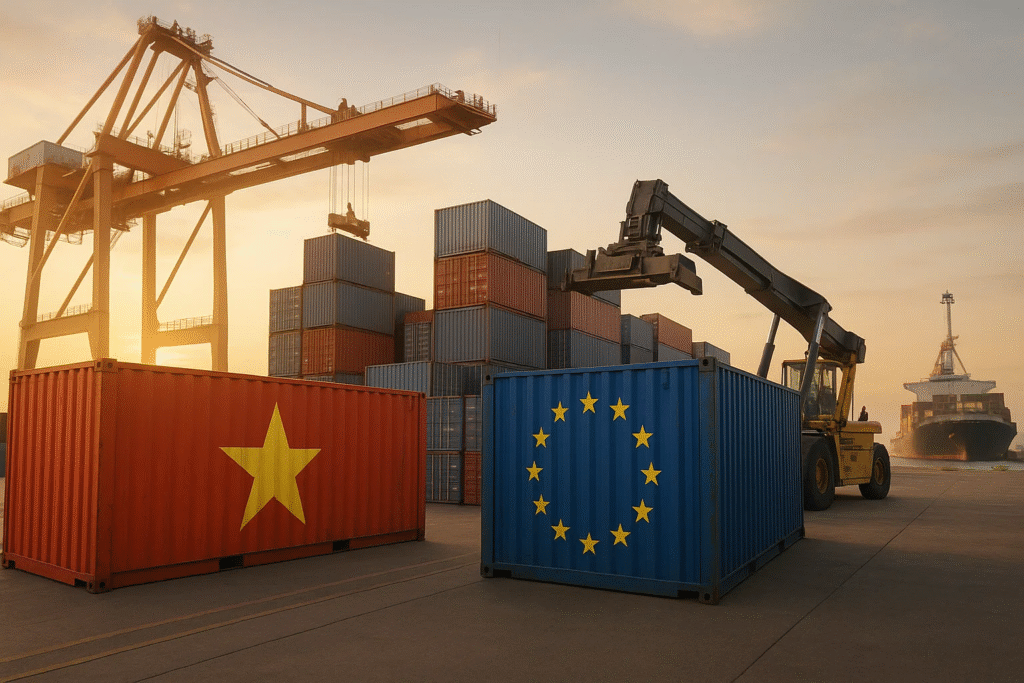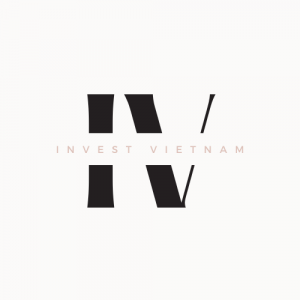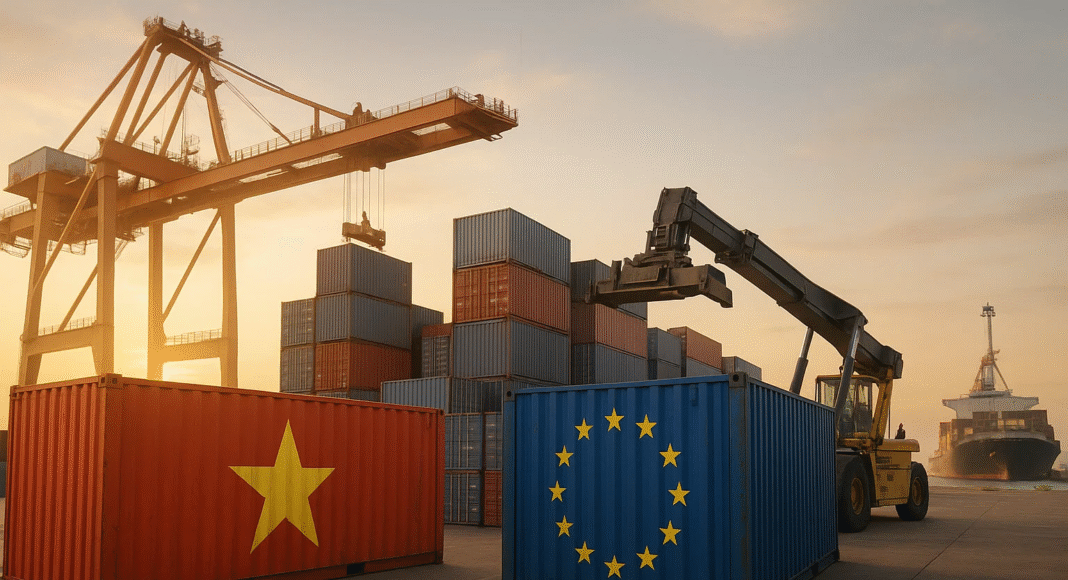Key Takeaways
- The EVFTA helped Vietnam-EU trade surpass $300 billion by eliminating tariffs and boosting export competitiveness.
- Legal reforms and improved market access attracted significant EU investment into key Vietnamese sectors.
- Ongoing cooperation in sustainability, digital trade, and regulatory alignment will shape the agreement’s long-term impact.
Five years since the European Union–Vietnam Free Trade Agreement (EVFTA) officially came into force in August 2020, the trade partnership between Vietnam and the EU has undergone a remarkable transformation. Valued at nearly $300 billion in cumulative bilateral trade over the past five years, the EVFTA stands as a pivotal milestone in Vietnam’s international trade agenda. It reflects not only the deepening integration of Vietnam into global supply chains but also the increasing maturity of its economic institutions, legal frameworks, and export competitiveness. As a new-generation free trade agreement, the EVFTA has unlocked unparalleled opportunities for Vietnamese exporters, EU investors, and consumers in both regions, while simultaneously presenting complex challenges that require continuous regulatory adaptation.

The landmark agreement eliminated approximately 99% of customs duties between the two parties over a multi-year period. For Vietnam, this meant immediate and preferential access to one of the world’s most lucrative consumer markets—home to over 450 million people with high purchasing power. Key Vietnamese exports such as textiles, electronics, seafood, agricultural goods, and furniture have benefitted significantly from reduced tariffs and streamlined trade procedures. Conversely, the EU has gained access to a dynamic and rapidly growing market of nearly 100 million consumers, offering expanded opportunities for pharmaceutical products, machinery, high-end goods, and green technologies.
From a legal and institutional standpoint, the EVFTA has prompted Vietnam to enhance compliance with international labor, environmental, and intellectual property standards. This has strengthened Vietnam’s business climate, making it more attractive to European investors seeking diversification beyond China. In particular, sectors such as renewable energy, manufacturing, logistics, and digital services have seen increasing EU interest, supported by Vietnam’s strategic location in Southeast Asia and its growing domestic consumption. Moreover, the agreement includes robust provisions for dispute settlement, public procurement, sustainable development, and transparency—components that have driven reforms and increased accountability in Vietnam’s regulatory environment.
However, the path has not been without friction. Despite substantial gains, challenges remain in fully realizing the EVFTA’s potential. Non-tariff barriers, technical trade standards, and differences in regulatory frameworks continue to hinder the full liberalisation of trade flows. Many Vietnamese small and medium-sized enterprises (SMEs) still face difficulties in meeting stringent EU standards on quality, traceability, and environmental sustainability. Meanwhile, EU exporters encounter issues related to customs procedures, administrative delays, and lack of alignment in investment protection mechanisms.
Over the past five years, Vietnam has demonstrated a proactive approach in addressing these challenges. Through institutional strengthening, improved trade facilitation infrastructure, and capacity-building programs, the government is working to ensure that the EVFTA remains a cornerstone of long-term economic growth and integration. This includes digitalising customs systems, enhancing legal enforcement of trade-related legislation, and expanding support for SME internationalisation.
As the EVFTA enters its next phase of implementation, the trajectory of Vietnam–EU trade cooperation offers valuable insights into how a developing country can leverage high-standard free trade agreements to enhance economic resilience and global competitiveness. This blog takes a comprehensive look at the last five years of the EVFTA, analyzing the legal, economic, and policy dynamics that have shaped Vietnam-EU trade relations. It explores how Vietnam managed to reach nearly $300 billion in bilateral trade, the sectors that gained most, the institutional reforms triggered by the agreement, and what lies ahead in the evolving landscape of international commerce.
Five Years of EVFTA: How Vietnam–EU Trade Surged to US$300 Billion
A Transformative Bilateral Trade Milestone
- In the five years since the EU–Vietnam Free Trade Agreement (EVFTA) entered into force on August 1, 2020, bilateral trade volume has surged to nearly US$300 billion.
- This accounts for approximately 40% of the total Vietnam–EU trade volume accumulated over the past 30 years, highlighting the agreement’s catalytic effect.
- Vietnam has emerged as the EU’s top trading partner in ASEAN and the 16th largest globally, marking a new era in intercontinental trade ties.
EVFTA Structure and Commitments
- Signed: June 30, 2019
- Entered into Force: August 1, 2020
- Immediate Impact:
- 85.6% of tariffs on Vietnamese exports to the EU eliminated upon entry into force
- Over 99% of tariff lines will be phased out by 2027
- Key Components Beyond Tariffs:
- Enhanced access to services and public procurement markets
- Strengthened intellectual property enforcement
- Greater regulatory transparency and legal harmonisation
- Promotion of sustainable development and labour standards
Trade Growth and Sectoral Expansion
Comparison of EU–Vietnam Trade Before and After EVFTA
| Period | Total Trade Volume | Vietnamese Exports to EU | Vietnamese Imports from EU |
|---|---|---|---|
| 2015–2019 (pre-EVFTA) | US$44.1 billion | US$31.1 billion | US$13 billion |
| 2020–2024 (EVFTA) | US$64.6 billion | US$48.7 billion | US$15.9 billion |
| Growth Rate | +46.5% | +56.4% | +13% |
High-Growth Sectors under EVFTA
- Agriculture, Forestry & Fisheries:
- Grew from US$3.76B (2019) to US$5.44B (2024) → +42.9%
- Annual average growth rate: 8.3%
- Notable Export Product Growth:
- Coffee: +120% (US$983M → US$2.2B)
- Footwear: +52.4% (US$3.7B → US$5.65B)
- Fruits & Vegetables: +65.6% (US$146M → US$242M)
Market Access and Business Sentiment
- According to EuroCham’s 2025 survey:
- 98.2% of European businesses active in Vietnam are aware of EVFTA benefits
- 66% engage in EU–Vietnam trade
- Share of firms citing tariff reduction as a key benefit rose from 29% in 2024 to 61% in 2025
- Many firms reported average revenue growth of 8.7%, with leaders reporting growth rates above 25%
Strategic Market Advantages
Vietnam’s Market Appeal
- Population: 100 million
- Workforce: 55 million
- Competitive labour costs and improving productivity
- Priority sectors:
- Digital economy
- Renewable energy
- High-tech manufacturing
- Smart agriculture
EU’s Strategic Role
- World’s largest single market:
- GDP (PPP): ~US$29 trillion
- Population: 450+ million
- GDP per capita: US$43,000+
- Offers:
- Transparent legal environment
- Demand for high-quality, sustainable imports
- Robust consumer base for Vietnamese goods
Institutional Reforms and Legal Modernisation
- In response to EVFTA, Vietnam implemented critical legal reforms:
- Labour Code (2021) and new IP Law amendments (2022)
- Ratification of ILO Conventions on collective bargaining and forced labour
- Environmental Protection Law (2020) emphasising sustainability commitments
- Regulatory transparency has significantly improved; however, enforcement remains uneven across regions and sectors
Ongoing Challenges: Barriers to Full Implementation
- Customs & Regulatory Frictions:
- 37% of firms report valuation discrepancies
- Inconsistent interpretations across customs offices
- Fragmented regulatory communication
- Rules of Origin Complexities:
- Many Vietnamese goods rely on third-country materials
- Complicated documentation requirements hinder compliance
- Cumulation rules are underutilised due to poor awareness and technical capacity
- Certificates of Origin:
- 56% of businesses submit monthly
- Essential for preferential treatment and credibility in EU markets
EVFTA’s Role in Future Trade Architecture
- Vietnam is a signatory of 17 FTAs, positioning itself as a regional trade hub
- Globally, 328 FTAs are now in force, compared to 98 in 2000
- The pending EU–Vietnam Investment Protection Agreement (EVIPA) is expected to:
- Offer long-term legal certainty for European investors
- Encourage capital inflow into strategic sectors
- Momentum is building towards a comprehensive strategic partnership, focusing on:
- Trade facilitation
- Climate cooperation
- Governance and institutional resilience
Strategic Summary Matrix
| Strategic Area | Progress Achieved | Remaining Gaps |
|---|---|---|
| Tariff Elimination | 85.6% eliminated; 99.2% by 2027 | SME access to preferential rates |
| Trade Volume | +US$300B in 5 years | More balanced sector diversification |
| Legal Reforms | ILO, environmental & IP laws updated | Enforcement and decentralised compliance |
| Business Engagement | 98.2% awareness; 8.7% avg. growth | Rules of Origin and customs clarity |
| Institutional Framework | EVIPA ratification underway | Limited cross-border regulatory coherence |
| Sustainable Integration | Renewable, agri-food growth noted | Green finance and ESG monitoring |
The Road Ahead: EVFTA as a Modern Trade Blueprint
- EVFTA is more than a trade deal — it is a platform for comprehensive, strategic, and sustainable collaboration
- With the global trade system under pressure from geopolitical tensions, Vietnam–EU relations under EVFTA exemplify a high-trust, rules-based model
- Continuous improvement in technical capacity, legal alignment, and mutual enforcement mechanisms is key to unlocking its full potential
Conclusion
The five-year journey of the European Union–Vietnam Free Trade Agreement (EVFTA) marks a defining chapter in Vietnam’s international economic integration. With nearly $300 billion in accumulated bilateral trade value since its implementation in 2020, the EVFTA has not only surpassed initial expectations but also reinforced Vietnam’s position as one of the EU’s most dynamic and reliable trade partners in Asia. This historic agreement has served as a catalyst for broader economic transformation—unlocking new markets, enhancing legal frameworks, upgrading production capabilities, and deepening institutional reforms within Vietnam’s rapidly evolving trade ecosystem.
The elimination of tariffs on a vast array of goods has generated tangible gains for both Vietnamese and European stakeholders. Vietnamese exporters have benefited from preferential access to a high-value consumer market, particularly in sectors such as textiles, seafood, electronics, coffee, and agricultural produce. At the same time, European companies have found increasing opportunities in Vietnam’s expanding industrial base, infrastructure projects, clean energy initiatives, healthcare, and high-end manufacturing. The surge in two-way trade has been accompanied by a growing wave of foreign direct investment from Europe, much of it tied to Vietnam’s commitment to transparency, intellectual property rights, labor protection, and sustainable development under the EVFTA framework.
From a policy and governance standpoint, the EVFTA has significantly influenced Vietnam’s regulatory architecture. The agreement has prompted the government to align local laws with international norms, upgrade customs and administrative procedures, and adopt higher standards in product quality and sustainability. These structural improvements have elevated Vietnam’s appeal not just to EU businesses, but to global investors seeking a stable, rules-based trade environment in Southeast Asia.
Despite these gains, important challenges remain. The full implementation of EVFTA commitments—especially in areas such as public procurement, geographical indications, and non-tariff barrier removal—requires continued vigilance and coordinated action from both Vietnamese institutions and EU partners. Many SMEs in Vietnam still struggle to comply with complex European regulations, while some EU exporters face administrative delays and lack of regulatory clarity. Ensuring inclusive growth from the EVFTA’s benefits will depend on targeted capacity-building programs, enhanced digitalisation, stronger legal enforcement, and public-private collaboration.
Furthermore, the global trade environment is becoming increasingly complex due to shifting geopolitical alliances, rising protectionism, and supply chain reconfiguration. In this context, the EVFTA represents a strategic anchor for Vietnam, enabling it to diversify export markets, reduce dependency on single trading partners, and increase resilience against external shocks. As Vietnam continues to position itself as a manufacturing and innovation hub in Asia, the EVFTA will remain a foundational pillar of its trade diplomacy and economic development.
Looking ahead, the next phase of EVFTA implementation offers immense potential to deepen the partnership between Vietnam and the EU. By expanding cooperation in green growth, digital transformation, education, and innovation, both sides can enhance mutual prosperity and set new benchmarks for sustainable trade. The path forward will require sustained political will, business engagement, and multilateral coordination—but the first five years have clearly demonstrated that strategic free trade agreements like the EVFTA can deliver transformational outcomes.
In summary, the EVFTA has not only facilitated $300 billion in trade—it has redefined Vietnam’s global trade narrative. It has empowered businesses, strengthened institutions, and demonstrated that high-standard trade agreements can serve as powerful instruments for inclusive growth and long-term competitiveness. As Vietnam and the EU enter a new chapter in their trade relationship, the lessons and achievements of the past five years will serve as a guiding force for shaping the future of global commerce.
People Also Ask
What is the EVFTA and when was it implemented?
The EU-Vietnam Free Trade Agreement (EVFTA) is a bilateral trade pact that came into effect on August 1, 2020, aimed at reducing tariffs and boosting trade.
How much has trade between Vietnam and the EU grown under EVFTA?
Bilateral trade between Vietnam and the EU has reached nearly $300 billion in five years, driven by tariff cuts and improved market access.
Which sectors in Vietnam have benefited most from EVFTA?
Textiles, footwear, seafood, electronics, and agricultural exports have seen significant growth due to lower tariffs and easier EU access.
How has EVFTA impacted EU exports to Vietnam?
European exports to Vietnam have increased in pharmaceuticals, machinery, vehicles, and high-tech equipment thanks to reduced trade barriers.
What percentage of tariffs have been eliminated under EVFTA?
Nearly 99% of tariffs will be eliminated over time, with more than 65% removed at the agreement’s implementation.
Has EVFTA improved Vietnam’s legal and regulatory environment?
Yes, EVFTA has spurred reforms in areas such as customs, transparency, intellectual property, and labor standards to align with EU norms.
What are the key non-tariff barriers that still exist?
Challenges include complex documentation, lengthy customs procedures, technical standards, and inconsistent local regulations.
How has EVFTA affected Vietnam’s small and medium enterprises (SMEs)?
SMEs have gained better export opportunities but face difficulties in meeting strict EU standards and certification requirements.
Has foreign direct investment (FDI) from the EU increased in Vietnam?
Yes, the EVFTA has attracted more EU investment, particularly in renewable energy, manufacturing, logistics, and high-tech sectors.
Which EU countries are Vietnam’s top trading partners under EVFTA?
Germany, the Netherlands, France, Italy, and Belgium are among Vietnam’s leading EU trade partners since the EVFTA’s implementation.
What is the role of Rules of Origin in the EVFTA?
Rules of Origin determine whether products qualify for tariff preferences and have encouraged local sourcing and production upgrades.
What are the challenges in fully implementing EVFTA?
Challenges include slow institutional adaptation, limited SME readiness, technical trade barriers, and gaps in regulatory enforcement.
How has the EVFTA impacted Vietnam’s agricultural exports?
Vietnam’s agricultural exports to the EU, such as coffee, pepper, and fruit, have grown due to lower duties and improved food safety standards.
Does EVFTA include labor and environmental commitments?
Yes, the agreement contains binding commitments to protect labor rights and promote environmental sustainability in trade.
What is the impact of EVFTA on Vietnam’s GDP?
Studies suggest the EVFTA could boost Vietnam’s GDP by 2-3% over the medium term due to expanded trade and investment flows.
How does EVFTA affect intellectual property rights in Vietnam?
The agreement has strengthened IP protection and enforcement, benefiting creators, innovators, and foreign investors.
Is EVFTA helping Vietnam diversify its export markets?
Yes, EVFTA has reduced Vietnam’s reliance on traditional partners like China and the U.S. by expanding access to the European market.
How has the EVFTA affected customs procedures in Vietnam?
Vietnam has modernized its customs processes and increased digitalization to facilitate faster and more transparent trade.
Are there any quotas under the EVFTA?
Yes, some agricultural and food products are subject to tariff-rate quotas, with limited volumes enjoying preferential access.
What support is available for Vietnamese businesses to use EVFTA?
Government agencies, trade associations, and EU-funded programs offer training, market information, and certification support.
Has the EVFTA improved product quality standards in Vietnam?
Yes, to access the EU market, Vietnamese exporters have had to raise product standards, improve packaging, and adopt traceability.
What is the significance of geographical indications (GIs) in EVFTA?
The agreement protects hundreds of EU and Vietnamese GIs, promoting regional brands and improving market recognition.
Are services and public procurement included in EVFTA?
Yes, the agreement opens up services sectors and improves transparency in public procurement, allowing EU firms to bid competitively.
How does the EVFTA align with other trade agreements Vietnam has?
EVFTA complements other FTAs like CPTPP and RCEP, reinforcing Vietnam’s commitment to open, rules-based trade.
What role does digital trade play in EVFTA’s future potential?
Digital trade is an emerging area where Vietnam and the EU are expanding cooperation, especially in e-commerce and data governance.
Has Vietnam faced any penalties for non-compliance with EVFTA terms?
So far, no major penalties have been imposed, but regular evaluations ensure that Vietnam complies with its obligations.
How are sustainable development goals integrated into EVFTA?
The EVFTA includes a Trade and Sustainable Development chapter to align trade with labor rights, climate commitments, and sustainability.
What is the long-term vision for EVFTA?
The EVFTA aims to build a deeper, more balanced economic partnership that supports innovation, sustainability, and mutual growth.
How can European businesses benefit more from EVFTA?
By increasing local engagement, understanding market dynamics, and leveraging preferential treatment under the agreement.
What lessons can other countries learn from the EVFTA experience?
EVFTA showcases how high-standard FTAs can boost trade, drive reforms, and strengthen international cooperation for shared prosperity.
Sources
vietnamnews.vn
vietbao.vn
vietnamagriculture.nongnghiep.vn
vietnamnet.vn
vir.com.vn
World Bank
CIEM (Central Institute for Economic Management)
EuroCham (European Chamber of Commerce in Vietnam)
WTO (World Trade Organization)
en.wikipedia.org

